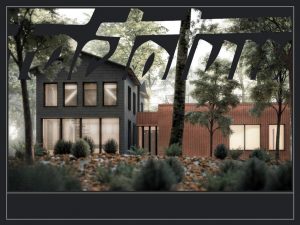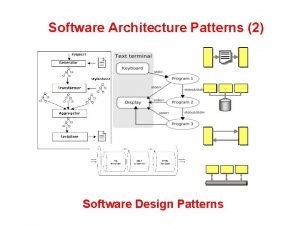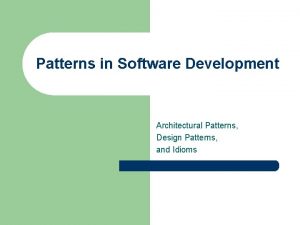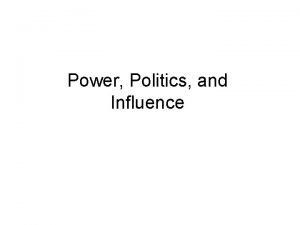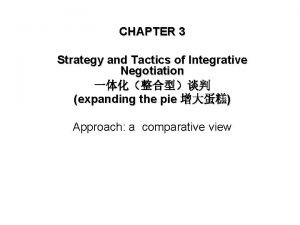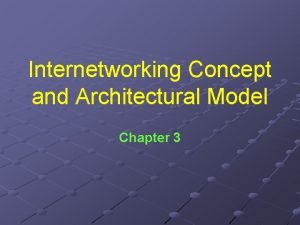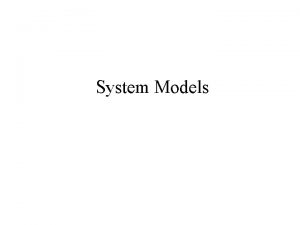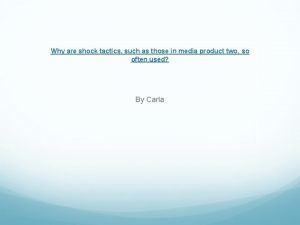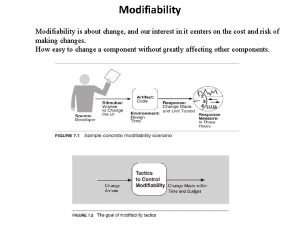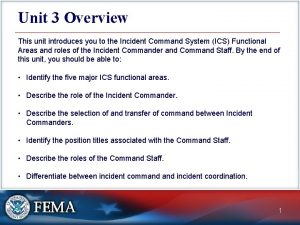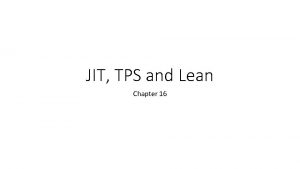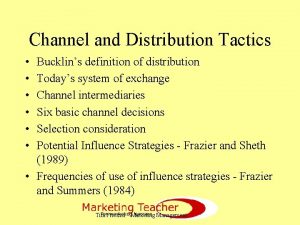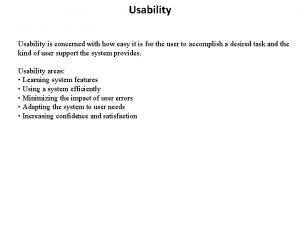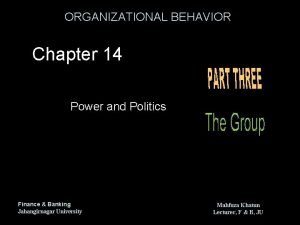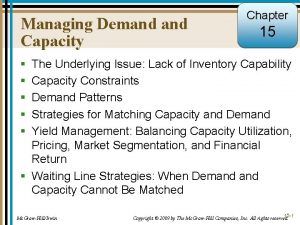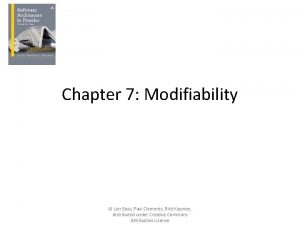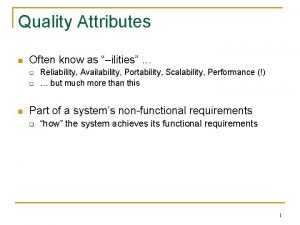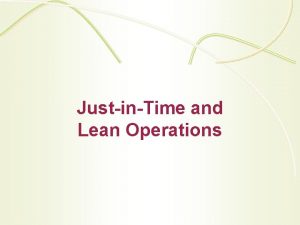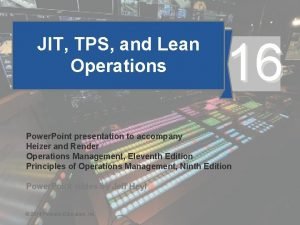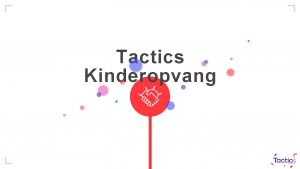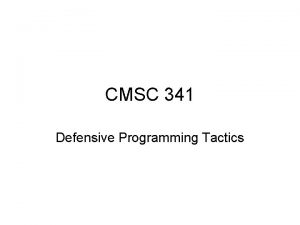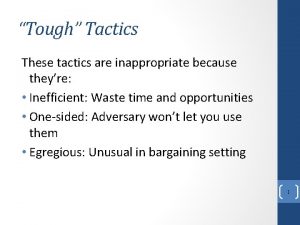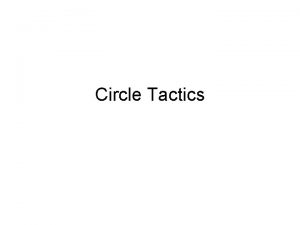Architectural Patterns and Tactics J Scott HawkerR Kuehl




























































- Slides: 60

Architectural Patterns and Tactics J. Scott Hawker/R. Kuehl p. 1 © Len Bass, Paul Clements, Rick Kazman, distributed under Creative Commons Attribution License

Outline · What is a Pattern? · Pattern Catalog - Module patterns - Component and Connector Patterns - Allocation Patterns · Architecture Tactics · Summary J. Scott Hawker/R. Kuehl p. 2 © Len Bass, Paul Clements, Rick Kazman, distributed under Creative Commons Attribution License

What is an Architectural Pattern? J. Scott Hawker/R. Kuehl p. 3 © Len Bass, Paul Clements, Rick Kazman, distributed under Creative Commons Attribution License

Patterns – a Review · Work on software patterns stemmed from work on patterns for building architecture carried out by Christopher Alexander (A Pattern Language: Towns, Buildings, Construction (1977)) · All well-structured software systems are full of patterns - Program idioms – language specific convention for programming tasks - Design patterns – component level design - Architectural patterns – system level structural organization J. Scott Hawker/R. Kuehl p. 4 © Len Bass, Paul Clements, Rick Kazman, distributed under Creative Commons Attribution License

What is a Software Architectural Pattern? · A pattern is a solution to a problem in a context - Context. A recurring, common situation in the world that gives rise to a problem. - Problem. The problem, appropriately generalized, that arises in the given context. - A solution. A successful architectural resolution to the problem, appropriately abstracted · An architectural pattern expresses a fundamental structural organization abstraction for software systems - A set of predefined subsystems - Their relationships - Rules and guidelines for organizing the relationships between them J. Scott Hawker/R. Kuehl p. 5 © Len Bass, Paul Clements, Rick Kazman, distributed under Creative Commons Attribution License

Software Architecture Patterns · Versus software design patterns – higher level system wide in scope; some overlap · Most software systems cannot be structured according to a single architectural pattern Example: Design a system for flexibility of component distribution in a heterogeneous computer network and for adaptability of their user interfaces J. Scott Hawker/R. Kuehl p. 6 © Len Bass, Paul Clements, Rick Kazman, distributed under Creative Commons Attribution License

Describing a Pattern Solution · A pattern solution is determined and described by: - A set of element types (for example, data repositories, processes, and objects) - A set of interaction mechanisms or connectors (for example, method calls, events, or message bus) - A topological layout of the components - A set of semantic constraints covering topology, element behavior, and interaction mechanisms - i. e. , views · To be useful, patterns are cataloged J. Scott Hawker/R. Kuehl p. 7 © Len Bass, Paul Clements, Rick Kazman, distributed under Creative Commons Attribution License

A Pattern Catalog Module Component & Connector Allocation Layered Broker Map-Reduce Domain decomposition Model-View-Controller Multi-tier functional mapping Pipe-and-Filter Platform Client-Server Team work allocation Peer-to-Peer Service-Oriented Architecture Publish-Subscribe Shared-Data J. Scott Hawker/R. Kuehl p. 8 © Len Bass, Paul Clements, Rick Kazman, distributed under Creative Commons Attribution License

Layer Pattern · · · Context: All complex systems experience the need to develop and evolve portions of the system independently. For this reason the developers of the system need a clear and well-documented separation of concerns, so that modules of the system may be independently developed and maintained. Problem: The software needs to be segmented in such a way that the modules can be developed and evolved separately with little interaction among the parts, supporting portability, modifiability, and reuse. Solution: To achieve this separation of concerns, the layered pattern divides the software into units called layers. Each layer is a grouping of modules that offers a cohesive set of services. The usage must be unidirectional. Layers completely partition a set of software, and each partition is exposed through a public interface. J. Scott Hawker/R. Kuehl p. 9 © Len Bass, Paul Clements, Rick Kazman, distributed under Creative Commons Attribution License

Layer Pattern Example J. Scott Hawker/R. Kuehl p. 10 © Len Bass, Paul Clements, Rick Kazman, distributed under Creative Commons Attribution License

UML Package Notation for Layer Diagrams Note: The textbook uses various informal architecture notations. That is OK if you use legends (keys) to explain the components, connectors, and structures. J. Scott Hawker/R. Kuehl p. 11 © Len Bass, Paul Clements, Rick Kazman, distributed under Creative Commons Attribution License

Layer Pattern Solution · · · Overview: The layered pattern defines layers (groupings of modules that offer a cohesive set of services) and a unidirectional allowed-to-use relation among the layers. Elements: Layer, a kind of module. The description of a layer should define what modules the layer contains. Relations: Allowed to use. The design should define what the layer usage rules are and any allowable exceptions. Constraints: - Every piece of software is allocated to exactly one layer. - There at least two layers (but usually there are three or more). - The allowed-to-use relations should not be circular (i. e. , a lower layer cannot use a layer above). Weaknesses: - The addition of layers adds up-front cost and complexity to a system. - Layers contribute a performance penalty. J. Scott Hawker/R. Kuehl p. 12 © Len Bass, Paul Clements, Rick Kazman, distributed under Creative Commons Attribution License

Broker Pattern · · · Context: Many systems are constructed from a collection of services distributed across multiple servers. Implementing these systems is complex because you need to worry about how the systems will interoperate—how they will connect to each other and how they will exchange information—as well as the availability of the component services. Problem: How do we structure distributed software so that service users do not need to know the nature and location of service providers, making it easy to dynamically change the bindings between users and providers? Solution: The broker pattern separates users of services (clients) from providers of services (servers) by inserting an intermediary, called a broker. When a client needs a service, it queries a broker via a service interface. The broker then forwards the client’s service request to a server, which processes the request. J. Scott Hawker/R. Kuehl p. 13 © Len Bass, Paul Clements, Rick Kazman, distributed under Creative Commons Attribution License

Broker Example J. Scott Hawker/R. Kuehl p. 14 © Len Bass, Paul Clements, Rick Kazman, distributed under Creative Commons Attribution License

Broker Solution – 1 · · Overview: The broker pattern defines a runtime component, called a broker, that mediates the communication between a number of clients and servers. Elements: - Client, a requester of services - Server, a provider of services - Broker, an intermediary that locates an appropriate server to fulfill a client’s request, forwards the request to the server, and returns the results to the client - Client-side proxy, an intermediary that manages the actual communication with the broker, including marshaling, sending, and unmarshaling of messages - Server-side proxy, an intermediary that manages the actual communication with the broker, including marshaling, sending, and unmarshaling of messages J. Scott Hawker/R. Kuehl p. 15 © Len Bass, Paul Clements, Rick Kazman, distributed under Creative Commons Attribution License

Broker Solution - 2 · · · Relations: The attachment relation associates clients (and, optionally, client-side proxies) and servers (and, optionally, server-side proxies) with brokers. Constraints: The client can only attach to a broker (potentially via a client-side proxy). The server can only attach to a broker (potentially via a server-side proxy). Weaknesses: - Brokers add a layer of indirection, and hence latency, between clients and servers, and that layer may be a communication bottleneck. - The broker can be a single point of failure. - A broker adds up-front complexity. - A broker may be a target for security attacks. - A broker may be difficult to test. J. Scott Hawker/R. Kuehl p. 16 © Len Bass, Paul Clements, Rick Kazman, distributed under Creative Commons Attribution License

Model-View-Controller Pattern · · · Context: User interface software is typically the most frequently modified portion of an interactive application. Users often wish to look at data from different perspectives, such as a bar graph or a pie chart. These representations should both reflect the current state of the data. Problem: How can user interface functionality be kept separate from application functionality and yet still be responsive to user input, or to changes in the underlying application’s data? And how can multiple views of the user interface be created, maintained, and coordinated when the underlying application data changes? Solution: The model-view-controller (MVC) pattern separates application functionality into three kinds of components: - A model, which contains the application’s data - A view, which displays some portion of the underlying data and interacts with the user - A controller, which mediates between the model and the view and manages the notifications of state changes J. Scott Hawker/R. Kuehl p. 17 © Len Bass, Paul Clements, Rick Kazman, distributed under Creative Commons Attribution License

MVC Example J. Scott Hawker/R. Kuehl p. 18 © Len Bass, Paul Clements, Rick Kazman, distributed under Creative Commons Attribution License

MVC Solution - 1 · · Overview: The MVC pattern breaks system functionality into three components: a model, a view, and a controller that mediates between the model and the view. Elements: - The model is a representation of the application data or state, and it contains (or provides an interface to) application logic. - The view is a user interface component that either produces a representation of the model for the user or allows for some form of user input, or both. - The controller manages the interaction between the model and the view, translating user actions into changes to the model or changes to the view. J. Scott Hawker/R. Kuehl p. 19 © Len Bass, Paul Clements, Rick Kazman, distributed under Creative Commons Attribution License

MVC Solution - 2 · · Relations: The notifies relation connects instances of model, view, and controller, notifying elements of relevant state changes. Constraints: · Weaknesses: - There must be at least one instance each of model, view, and controller. - The model component should not interact directly with the controller. - The complexity may not be worth it for simple user interfaces. - The model, view, and controller abstractions may not be good fits for some user interface toolkits. J. Scott Hawker/R. Kuehl p. 20 © Len Bass, Paul Clements, Rick Kazman, distributed under Creative Commons Attribution License

Pipe and Filter Pattern · · · Context: Many systems are required to transform streams of discrete data items, from input to output. Many types of transformations occur repeatedly in practice, and so it is desirable to create these as independent, reusable parts. Problem: Such systems need to be divided into reusable, loosely coupled components with simple, generic interaction mechanisms. In this way they can be flexibly combined with each other. The components, being generic and loosely coupled, are easily reused. The components, being independent, can execute in parallel. Solution: The pattern of interaction in the pipe-and-filter pattern is characterized by successive transformations of streams of data. Data arrives at a filter’s input port(s), is transformed, and then is passed via its output port(s) through a pipe to the next filter. A single filter can consume data from, or produce data to, one or more ports. J. Scott Hawker/R. Kuehl p. 21 © Len Bass, Paul Clements, Rick Kazman, distributed under Creative Commons Attribution License

Pipe and Filter Example J. Scott Hawker/R. Kuehl p. 22 © Len Bass, Paul Clements, Rick Kazman, distributed under Creative Commons Attribution License

Pipe and Filter Solution · · Overview: Data is transformed from a system’s external inputs to its external outputs through a series of transformations performed by its filters connected by pipes. Elements: - Filter, which is a component that transforms data read on its input port(s) to data written on its output port(s). - Pipe, which is a connector that conveys data from a filter’s output port(s) to another filter’s input port(s). A pipe has a single source for its input and a single target for its output. A pipe preserves the sequence of data items, and it does not alter the data passing through. Relations: The attachment relation associates the output of filters with the input of pipes and vice versa. Constraints: - Pipes connect filter output ports to filter input ports. - Connected filters must agree on the type of data being passed along the connecting pipe. J. Scott Hawker/R. Kuehl p. 23 © Len Bass, Paul Clements, Rick Kazman, distributed under Creative Commons Attribution License

Client-Server Pattern · · · Context: There are shared resources and services that large numbers of distributed clients wish to access, and for which we wish to control access or quality of service. Problem: By managing a set of shared resources and services, we can promote modifiability and reuse, by factoring out common services and having to modify these in a single location, or a small number of locations. We want to improve scalability and availability by centralizing the control of these resources and services, while distributing the resources themselves across multiple physical servers. Solution: Clients interact by requesting services of servers, which provide a set of services. Some components may act as both clients and servers. There may be one central server or multiple distributed ones. J. Scott Hawker/R. Kuehl p. 24 © Len Bass, Paul Clements, Rick Kazman, distributed under Creative Commons Attribution License

Client-Server Example ATM Banking System J. Scott Hawker/R. Kuehl p. 25 © Len Bass, Paul Clements, Rick Kazman, distributed under Creative Commons Attribution License

Client-Server Solution - 1 · · Overview: Clients initiate interactions with servers, invoking services as needed from those servers and waiting for the results of those requests. Elements: - Client, a component that invokes services of a server component. Clients have ports that describe the services they require. - Server: a component that provides services to clients. Servers have ports that describe the services they provide. · Request/reply connector: a data connector employing a request/reply protocol, used by a client to invoke services on a server. Important characteristics include whether the calls are local or remote, and whether data is encrypted. J. Scott Hawker/R. Kuehl p. 26 © Len Bass, Paul Clements, Rick Kazman, distributed under Creative Commons Attribution License

Client-Server Solution- 2 · Relations: The attachment relation associates clients with servers. · Constraints: - Clients are connected to servers through request/reply connectors. - Server components can be clients to other servers. · Weaknesses: - Server can be a performance bottleneck. - Server can be a single point of failure. - Decisions about where to locate functionality (in the client or in the server) are often complex and costly to change after a system has been built. J. Scott Hawker/R. Kuehl p. 27 © Len Bass, Paul Clements, Rick Kazman, distributed under Creative Commons Attribution License

Peer-to-Peer Pattern · · · Context: Distributed computational entities— each of which is considered equally important in terms of initiating an interaction and each of which provides its own resources—need to cooperate and collaborate to provide a service to a distributed community of users. Problem: How can a set of “equal” distributed computational entities be connected to each other via a common protocol so that they can organize and share their services with high availability and scalability? Solution: In the peer-to-peer (P 2 P) pattern, components directly interact as peers. All peers are “equal” and no peer or group of peers can be critical for the health of the system. Peer-to-peer communication is typically a request/reply interaction without the asymmetry found in the client-server pattern. J. Scott Hawker/R. Kuehl p. 28 © Len Bass, Paul Clements, Rick Kazman, distributed under Creative Commons Attribution License

Peer-to-Peer Example Gnutella Network J. Scott Hawker/R. Kuehl p. 29 © Len Bass, Paul Clements, Rick Kazman, distributed under Creative Commons Attribution License

Peer-to-Peer Solution - 1 · · Overview: Computation is achieved by cooperating peers that request service from and provide services to one another across a network. Elements: - Peer, which is an independent component running on a network node. Special peer components can provide routing, indexing, and peer search capability. - Request/reply connector, which is used to connect to the peer network, search for other peers, and invoke services from other peers. In some cases, the need for a reply is done away with. · Relations: The relation associates peers with their connectors. Attachments may change at runtime. J. Scott Hawker/R. Kuehl p. 30 © Len Bass, Paul Clements, Rick Kazman, distributed under Creative Commons Attribution License

Peer-to-Peer Solution - 2 · Constraints: Restrictions may be placed on the following: - The number of allowable attachments to any given peer The number of hops used for searching for a peer Which peers know about which other peers Some P 2 P networks are organized with star topologies, in which peers only connect to supernodes. · Weaknesses: - Managing security, data consistency, data/service availability, backup, and recovery are all more complex. - Small peer-to-peer systems may not be able to consistently achieve quality goals such as performance and availability. J. Scott Hawker/R. Kuehl p. 31 © Len Bass, Paul Clements, Rick Kazman, distributed under Creative Commons Attribution License

Service Oriented Architecture Pattern • Context: A number of services are offered (and described) by service providers and consumed by service consumers. Service consumers need to be able to understand use these services without any detailed knowledge of their implementation. · Problem: How can we support interoperability of distributed components running on different platforms and written in different implementation languages, provided by different organizations, and distributed across the Internet? · Solution: The service-oriented architecture (SOA) pattern describes a collection of distributed components that provide and/or consume services. J. Scott Hawker/R. Kuehl p. 32 © Len Bass, Paul Clements, Rick Kazman, distributed under Creative Commons Attribution License

Service Oriented Architecture Example “Adventure Builder” OPC – Order Processing Center J. Scott Hawker/R. Kuehl p. 33 © Len Bass, Paul Clements, Rick Kazman, distributed under Creative Commons Attribution License

Service Oriented Architecture Solution - 1 · · Overview: Computation is achieved by a set of cooperating components that provide and/or consume services over a network. Elements: - Components: § Service providers, which provide one or more services through published interfaces. § Service consumers, which invoke services directly or through an intermediary. § Service providers may also be service consumers. - Enterprise Service Bus (ESB), which is an intermediary element that can route and transform messages between service providers and consumers. - Registry of services, which may be used by providers to register their services and by consumers to discover services at runtime. - Orchestration server, which coordinates the interactions between service consumers and providers based on languages for business processes and workflows. J. Scott Hawker/R. Kuehl p. 34 © Len Bass, Paul Clements, Rick Kazman, distributed under Creative Commons Attribution License

Service Oriented Architecture Solution - 2 - Connectors: § SOAP connector, which uses the SOAP protocol for synchronous communication between web services, typically over HTTP. § REST connector, which relies on the basic request/reply operations of the HTTP protocol. § Asynchronous messaging connector, which uses a messaging system to offer point -to-point or publish-subscribe asynchronous message exchanges. J. Scott Hawker/R. Kuehl p. 35 © Len Bass, Paul Clements, Rick Kazman, distributed under Creative Commons Attribution License

Service Oriented Architecture Solution - 3 · · · Relations: Attachment of the different kinds of components available to the respective connectors Constraints: Service consumers are connected to service providers, but intermediary components (e. g. , ESB, registry, orchestration server) may be used. Weaknesses: - SOA-based systems are typically complex to build. - You don’t control the evolution of independent services. - There is a performance overhead associated with the middleware, and services may be performance bottlenecks, and typically do not provide performance guarantees. J. Scott Hawker/R. Kuehl p. 36 © Len Bass, Paul Clements, Rick Kazman, distributed under Creative Commons Attribution License

Publish-Subscribe Pattern · · · Context: There a number of independent producers and consumers of data that must interact. The precise number and nature of the data producers and consumers are not predetermined or fixed, nor is the data that they share. Problem: How can we create integration mechanisms that support the ability to transmit messages among the producers and consumers so they are unaware of each other’s identity, or potentially even their existence? Solution: In the publish-subscribe pattern, components interact via announced messages, or events. Components may subscribe to a set of events. Publisher components place events on the bus by announcing them; the connector then delivers those events to the subscriber components that have registered an interest in those events. J. Scott Hawker/R. Kuehl p. 37 © Len Bass, Paul Clements, Rick Kazman, distributed under Creative Commons Attribution License

Publish-Subscribe Example J. Scott Hawker/R. Kuehl p. 38 © Len Bass, Paul Clements, Rick Kazman, distributed under Creative Commons Attribution License

Publish-Subscribe Solution – 1 · · Overview: Components publish and subscribe to events. When an event is announced by a component, the connector infrastructure dispatches the event to all registered subscribers. Elements: - Any C&C component with at least one publish or subscribe port. - The publish-subscribe connector, which will have announce and listen roles for components that · wish to publish and subscribe to events. Relations: The attachment relation associates components with the publish-subscribe connector by prescribing which components announce events and which components are registered to receive events. J. Scott Hawker/R. Kuehl p. 39 © Len Bass, Paul Clements, Rick Kazman, distributed under Creative Commons Attribution License

Publish-Subscribe Solution - 2 · Constraints: All components are connected to an event distributor that may be viewed as either a bus—connector—or a component. Publish ports are attached to announce roles and subscribe ports are attached to listen roles. · Weaknesses: - Typically increases latency and has a negative effect on scalability and predictability of message delivery time. - Less control over ordering of messages, and delivery of messages is not guaranteed. J. Scott Hawker/R. Kuehl p. 40 © Len Bass, Paul Clements, Rick Kazman, distributed under Creative Commons Attribution License

Shared-Data Pattern · · · Context: Various computational components need to share and manipulate large amounts of data. This data does not belong solely to any one of those components. Problem: How can systems store and manipulate persistent data that is accessed by multiple independent components? Solution: In the shared-data pattern, interaction is dominated by the exchange of persistent data between multiple data accessors and at least one shared-data store. Exchange may be initiated by the accessors or the data store. The connector type is data reading and writing. J. Scott Hawker/R. Kuehl p. 41 © Len Bass, Paul Clements, Rick Kazman, distributed under Creative Commons Attribution License

Shared Data Example Enterprise Access Management System J. Scott Hawker/R. Kuehl p. 42 © Len Bass, Paul Clements, Rick Kazman, distributed under Creative Commons Attribution License

Shared Data Solution - 1 · Overview: Communication between data accessors is mediated by a shared data store. Control may be initiated by the data accessors or the data store. Data is made persistent by the data store. · Elements: - Shared-data store. Concerns include types of data stored, data performance-oriented properties, data distribution, and number of accessors permitted. - Data accessor component. - Data reading and writing connector. J. Scott Hawker/R. Kuehl p. 43 © Len Bass, Paul Clements, Rick Kazman, distributed under Creative Commons Attribution License

Shared Data Solution - 2 · Relations: Attachment relation determines which data accessors are connected to which data stores. · Constraints: Data accessors interact only with the data store(s). · Weaknesses: - The shared-data store may be a performance bottleneck. - The shared-data store may be a single point of failure. - Producers and consumers of data may be tightly coupled. J. Scott Hawker/R. Kuehl p. 44 © Len Bass, Paul Clements, Rick Kazman, distributed under Creative Commons Attribution License

Map-Reduce Pattern · · · Context: Businesses have a pressing need to quickly analyze enormous volumes of data they generate or access, at petabyte scale. Problem: For many applications with ultra-large data sets, sorting the data and then analyzing the grouped data is sufficient. The problem the map-reduce pattern solves is to efficiently perform a distributed and parallel sort of a large data set and provide a simple means for the programmer to specify the analysis to be done. Solution: The map-reduce pattern requires three parts: - A specialized infrastructure takes care of allocating software to the hardware nodes in a massively parallel computing environment and handles sorting the data as needed. - A programmer specified component called the map which filters the data to retrieve those items to be combined. - A programmer specified component called reduce which combines the results of the map J. Scott Hawker/R. Kuehl p. 45 © Len Bass, Paul Clements, Rick Kazman, distributed under Creative Commons Attribution License

Map-Reduce Example J. Scott Hawker/R. Kuehl p. 46 © Len Bass, Paul Clements, Rick Kazman, distributed under Creative Commons Attribution License

Map-Reduce Solution - 1 · · Overview: The map-reduce pattern provides a framework for analyzing a large distributed set of data that will execute in parallel, on a set of processors. This parallelization allows for low latency and high availability. The map performs the extract and transform portions of the analysis and the reduce performs the loading of the results. Elements: - Map is a function with multiple instances deployed across multiple processors that performs the extract and transformation portions of the analysis. - Reduce is a function that may be deployed as a single instance or as multiple instances across processors to perform the load portion of extract-transform-load. - The infrastructure is the framework responsible for deploying map and reduce instances, shepherding the data between them, and detecting and recovering from failure. J. Scott Hawker/R. Kuehl p. 47 © Len Bass, Paul Clements, Rick Kazman, distributed under Creative Commons Attribution License

Map-Reduce Solution - 2 · · · Relations: - Deploy on is the relation between an instance of a map or reduce function and the processor onto which it is installed. - Instantiate, monitor, and control is the relation between the infrastructure and the instances of map and reduce. Constraints: - The data to be analyzed must exist as a set of files. - Map functions are stateless and do not communicate with each other. - The only communication between map reduce instances is the data emitted from the map instances as <key, value> pairs. Weaknesses: - If you do not have large data sets, the overhead of map-reduce is not justified. - If you cannot divide your data set into similar sized subsets, the advantages of parallelism are lost. - Operations that require multiple reduces are complex to orchestrate. J. Scott Hawker/R. Kuehl p. 48 © Len Bass, Paul Clements, Rick Kazman, distributed under Creative Commons Attribution License

Multi-Tier Pattern · Context: In a distributed deployment, there is often a need to distribute a system’s infrastructure into distinct subsets. · Problem: How can we split the system into a number of computationally independent execution structures—groups of software and hardware—connected by some communications media? · Solution: The execution structures of many systems are organized as a set of logical groupings of components. Each grouping is termed a tier. J. Scott Hawker/R. Kuehl p. 49 © Len Bass, Paul Clements, Rick Kazman, distributed under Creative Commons Attribution License

Multi-Tier Example Consumer Web Site Java EE J. Scott Hawker/R. Kuehl p. 50 © Len Bass, Paul Clements, Rick Kazman, distributed under Creative Commons Attribution License

Multi-Tier Solution · · Overview: The execution structures of many systems are organized as a set of logical groupings of components. Each grouping is termed a tier. Elements: - Tier, which is a logical grouping of software components. · Relations: - Is part of, to group components into tiers. - Communicates with, to show tiers and the components they contain interact with each other. - Allocated to, in the case that tiers map to computing platforms. · · Constraints: A software component belongs to exactly one tier. Weaknesses: Substantial up-front cost and complexity. J. Scott Hawker/R. Kuehl p. 51 © Len Bass, Paul Clements, Rick Kazman, distributed under Creative Commons Attribution License

Achieving Quality Attributes Through Tactics · There a collection of primitive design techniques that an architect can use to achieve a quality attribute response · We call these architectural design primitives tactics · Tactics, like design patterns, are techniques that architects have been using for years - We do not invent tactics, we simply capture what architects do in practice J. Scott Hawker/R. Kuehl p. 52 © Len Bass, Paul Clements, Rick Kazman, distributed under Creative Commons Attribution License

J. Scott Hawker/R. Kuehl p. 53 © Len Bass, Paul Clements, Rick Kazman, distributed under Creative Commons Attribution License

J. Scott Hawker/R. Kuehl p. 54 © Len Bass, Paul Clements, Rick Kazman, distributed under Creative Commons Attribution License

J. Scott Hawker/R. Kuehl p. 55 © Len Bass, Paul Clements, Rick Kazman, distributed under Creative Commons Attribution License

J. Scott Hawker/R. Kuehl p. 56 © Len Bass, Paul Clements, Rick Kazman, distributed under Creative Commons Attribution License

J. Scott Hawker/R. Kuehl p. 57 © Len Bass, Paul Clements, Rick Kazman, distributed under Creative Commons Attribution License

J. Scott Hawker/R. Kuehl p. 58 © Len Bass, Paul Clements, Rick Kazman, distributed under Creative Commons Attribution License

J. Scott Hawker/R. Kuehl p. 59 © Len Bass, Paul Clements, Rick Kazman, distributed under Creative Commons Attribution License

Summary · An architectural pattern - is a package of design decisions that is found repeatedly in practice, - has known properties that permit reuse, and - describes a class of architectures. · Tactics are simpler than patterns · Patterns are underspecified with respect to real systems so they have to be augmented with tactics. - Augmentation ends when requirements for a specific system are satisfied. J. Scott Hawker/R. Kuehl p. 60 © Len Bass, Paul Clements, Rick Kazman, distributed under Creative Commons Attribution License
 C&c pattern
C&c pattern Applications of active filters
Applications of active filters Factotum fabricor
Factotum fabricor Architectural styles and patterns
Architectural styles and patterns Architectural patterns in software engineering
Architectural patterns in software engineering Architectural patterns in software engineering
Architectural patterns in software engineering Closed patterns and max-patterns
Closed patterns and max-patterns In traditional dating patterns dating behavior
In traditional dating patterns dating behavior Factors contributing to organizational politics
Factors contributing to organizational politics Volleyball hitting chart
Volleyball hitting chart Types of public relations
Types of public relations Sequencing strategies and tactics
Sequencing strategies and tactics Managerial economics applications strategy and tactics
Managerial economics applications strategy and tactics Strategy and tactics of integrative negotiation
Strategy and tactics of integrative negotiation 8 marketing management tasks
8 marketing management tasks Tactical communication skills
Tactical communication skills Main/subroutine architecture
Main/subroutine architecture Conceptual framework in iot
Conceptual framework in iot Internetworking architecture model
Internetworking architecture model Architectural model of distributed system
Architectural model of distributed system Shock tactics definition
Shock tactics definition Define strategic management
Define strategic management Interoperability quality attribute
Interoperability quality attribute Patrol tactics training
Patrol tactics training Modifiability
Modifiability Criminal addictive thinking worksheets
Criminal addictive thinking worksheets What tactics were used to win the “revolution of 1875”?
What tactics were used to win the “revolution of 1875”? Distributive strategy
Distributive strategy Ashley drew scare tactics
Ashley drew scare tactics Appeal to fear
Appeal to fear Amateurs talk strategy professionals talk logistics
Amateurs talk strategy professionals talk logistics Alexander the great's timeline
Alexander the great's timeline Availability tactics in software architecture
Availability tactics in software architecture Establish objectives make assignments and order resources
Establish objectives make assignments and order resources Iso iec fcd 25010
Iso iec fcd 25010 Microsoft offer negotiation
Microsoft offer negotiation Jit tps
Jit tps Choice tactics
Choice tactics Jingles are the message written around the brand
Jingles are the message written around the brand Receo vs fire
Receo vs fire Monitorability tactics
Monitorability tactics Distribution tactics
Distribution tactics Sead tactics
Sead tactics Usability tactics
Usability tactics Preferred power tactics by influence direction
Preferred power tactics by influence direction Strategies for shifting demand to match capacity
Strategies for shifting demand to match capacity Supplements for field hockey
Supplements for field hockey Modifiability tactics
Modifiability tactics What is he doing
What is he doing How to beat lady deathwhisper
How to beat lady deathwhisper Police defensive tactics
Police defensive tactics Unit 2 chapter 6 consumer awareness
Unit 2 chapter 6 consumer awareness Supply chain table
Supply chain table Presentation strategies & tactics
Presentation strategies & tactics Preferred power tactics by influence direction
Preferred power tactics by influence direction Steinberg triangle
Steinberg triangle Testability tactics
Testability tactics Jit scheduling tactics
Jit scheduling tactics What is jit
What is jit Jit scheduling tactics
Jit scheduling tactics Ttp techniques
Ttp techniques


